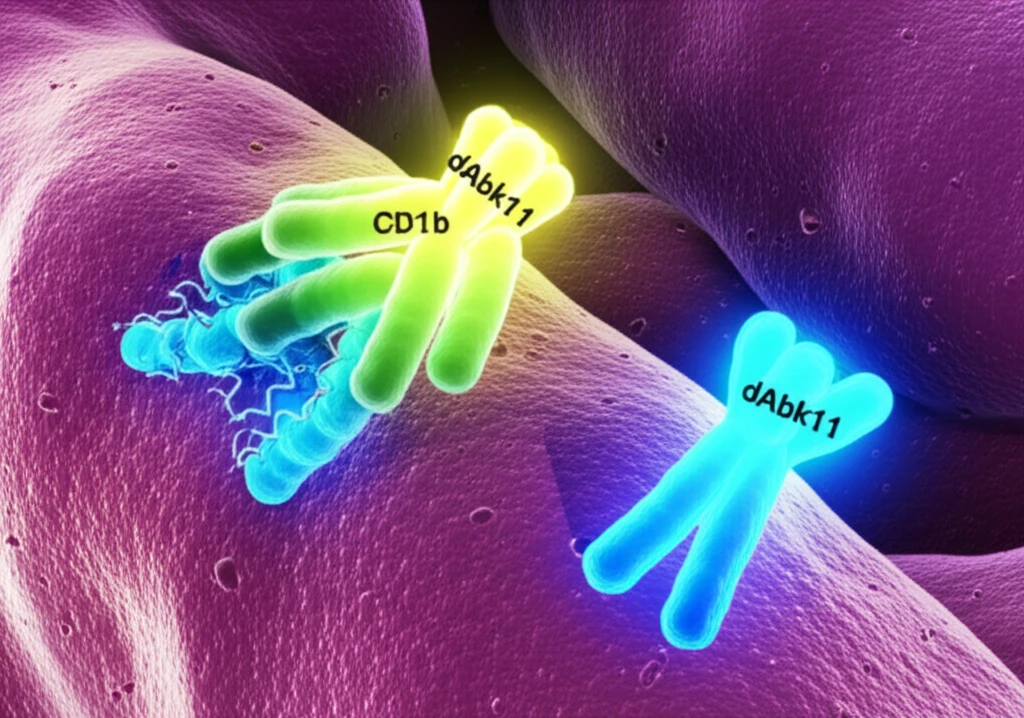
Decoding TB: How Antibodies Can Lead to Better Treatments
"Scientists explore how antibodies interact with tuberculosis-causing bacteria, paving the way for improved therapies and diagnostic tools."
Tuberculosis (TB) remains a leading cause of death worldwide, caused by the bacterium Mycobacterium tuberculosis (Mtb). Despite existing treatments, the rise of drug-resistant strains and the lack of a fully effective vaccine highlight the urgent need for innovative approaches to combat this disease. A crucial aspect of TB research involves understanding how the immune system recognizes and responds to Mtb.
CD1b molecules play a vital role in this immune response by presenting lipid antigens from Mtb to T cells, a type of immune cell. One such lipid antigen, Ac2SGL, is particularly important. Scientists have developed a special antibody, dAbҝ11, that specifically recognizes the CD1b molecule when it's bound to Ac2SGL. This antibody offers a valuable tool for studying this interaction.
A new study published in Tuberculosis journal delves into the intricate interactions between dAbҝ11 and the Ac2SGL-CD1b complex. By using molecular modeling and simulations, researchers have gained critical insights into how this antibody recognizes and binds to the TB-related complex, opening doors for developing more effective TB therapies and diagnostic tools.
Unlocking the TB Puzzle: Antibody Interactions at the Molecular Level

The research team used advanced computational techniques to model the interaction between dAbҝ11 and Ac2SGL-CD1b. They started by creating a detailed model of Ac2SGL within the CD1b binding groove. Then, they predicted how dAbҝ11 would interact with this complex using docking simulations and molecular dynamics, essentially creating a virtual movie of the interaction.
- Tyr32's Decisive Role: The amino acid tyrosine 32 (Tyr32) on the dAbҝ11 antibody is critical for interacting with the Ac2SGL lipid.
- Hydrophobic Interactions: Ac2SGL establishes strong hydrophobic interactions with dAbҝ11, meaning they tend to bind together in a way that avoids water.
- Preference for Natural Lipids: The antibody shows a higher affinity for the natural sulfoglycolipid (Ac2SGL) compared to a synthetic version (SGL12).
Toward Better TB Control: Optimizing Antibodies for Future Therapies
This research provides valuable insights into the molecular mechanisms of how dAbҝ11 recognizes the Ac2SGL-CD1b complex. This knowledge can be used to optimize dAbҝ11, potentially making it an even more effective tool for TB diagnosis or therapy. By understanding the key interactions, scientists can design modified antibodies with improved binding affinity and specificity.
The study also highlights the importance of using the natural TB lipid, Ac2SGL, in future research and development efforts. The preference of dAbҝ11 for Ac2SGL over synthetic analogs underscores the need to consider the specific structural features of native TB antigens when designing new diagnostic and therapeutic agents.
Ultimately, this research contributes to the ongoing quest for better ways to diagnose, treat, and prevent tuberculosis. By deciphering the intricate interactions between antibodies and TB lipids, scientists are paving the way for a future where TB is no longer a global health threat.
